Athetoid movements - Study guides, Class notes & Summaries
Looking for the best study guides, study notes and summaries about Athetoid movements? On this page you'll find 170 study documents about Athetoid movements.
Page 4 out of 170 results
Sort by
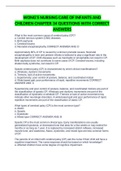
-
WONG'S NURSING CARE OF INFANTS AND CHILDREN CHAPTER 34 QUESTIONS WITH CORRECT ANSWERS
- Exam (elaborations) • 9 pages • 2022
-
- $5.99
- + learn more
What is the most common cause of cerebral palsy (CP)? a. Central nervous system (CNS) diseases b. Birth asphyxia c. Cerebral trauma d. Neonatal encephalophathy CORRECT ANSWER ANS: D Approximately 80% of CP is caused by unknown prenatal causes. Neonatal encephalopathy in term and preterm infants is believed to play a significant role in the development of CP. CNS diseases such as meningitis or encephalitis can result in CP. Birth asphyxia does not contribute to some cases of CP. Cerebral ...
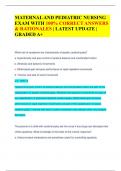
-
MATERNAL AND PEDIATRIC NURSING EXAM WITH 100% CORRECT ANSWERS & RATIONALES | LATEST UPDATE | GRADED A+
- Exam (elaborations) • 372 pages • 2024
-
- $10.99
- + learn more
Which set of symptoms are characteristic of spastic cerebral palsy? a. Hypertonicity and poor control of posture balance and coordinated motion b. Athetosis and dystonic movements c. Wide-based gait and poor performance of rapid repetitive movements d. Tremors and lack of active movement - ANS: A Hypertonicity poor control of posture balance and coordinated motion are part of the classification of spastic cerebral palsy. Athetosis and dystonic movements are part of the classification o...

-
Chapter 30: The Child with Neuromuscular or Muscular Dysfunction Hockenberry: Wong’s Essentials of Pediatric Nursing, 10th Edition Questions and Answers 2023
- Exam (elaborations) • 11 pages • 2023
- Available in package deal
-
- $10.49
- + learn more
1. The nurse is planning a staff in-service on childhood spastic cerebral palsy. What characterizes spastic cerebral palsy? a. Hypertonicity and poor control of posture, balance, and coordinated motion b. Athetosis and dystonic movements c. Wide-based gait and poor performance of rapid, repetitive movements d. Tremors and lack of active movement ANS: A Hypertonicity and poor control of posture, balance, and coordinated motion are part of the classification of spastic cerebral palsy. Athe...
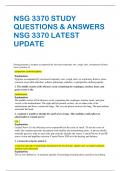
-
NSG 3370 STUDY QUESTIONS & ANSWERS NSG 3370 LATEST UPDATE
- Exam (elaborations) • 72 pages • 2024
-
- $12.99
- + learn more
NSG 3370 STUDY QUESTIONS & ANSWERS NSG 3370 LATEST UPDATE During pregnancy, dyspnea accompanied by increased respiratory rate, cough, rales, orrespiratory distress raises concerns of: peripartum cardiomyopathy Explanation: Dyspnea accompanied by increased respiratory rate, cough, rales, or respiratory distress raises concerns of possible infection, asthma, pulmonary embolus, or peripartum cardiomyopathy. 1. The middle section of the thoracic cavity containing the esophagus, trachea,...
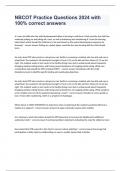
-
NBCOT Practice Questions 2024 with 100% correct answers
- Exam (elaborations) • 20 pages • 2024
-
- $14.39
- + learn more
A 5 year old child who has mild developmental delay is learning to self-dress. Most recently, the child has mastered putting on and taking off a coat, as well as buttoning and unbuttoning it. From the dressing tasks listed, which should the child learn to do next based on the typical development sequence for dressing? - correct answer Pulling up a jacket zipper would be the next dressing skill the child should learn. An entry level OTR who works in a long-term care facility is screening a res...
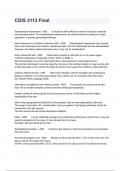
-
CDIS 3113 Final Questions And Questions
- Exam (elaborations) • 25 pages • 2024
-
- $11.39
- + learn more
CDIS 3113 Final CDIS 3113 Final Standardized Assessment - ANS It should be self-sufficient in terms of stimulus materials and recording forms. The standardized assessments are created based on testing of a large population to provide generalized findings. Norm-referenced vs Criterion reference tests - ANS Standardized assessment may include both norm-referenced and criterion- referenced tests. All norm referenced test are standardized. However, all criterion-referenced tests...
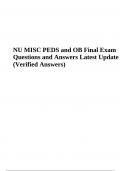
-
PEDS and OB Final Exam Questions and Answers Latest Updated 2024 (100% Verified Answers)
- Exam (elaborations) • 21 pages • 2024
-
- $18.49
- + learn more
PEDS and OB Final Exam Questions and Answers Latest Updated 2024 (100% Verified Answers) A child has a right femur fracture caused by a motor vehicle accident and is placed in skin traction temporarily until surgery can be performed. During assessment, the nurse notes that the dorsalis pedal pulse is absent on the right foot. What action should the nurse take? a. Notify the physician b. Administer an analgesic c. Release the skin traction d. Apply ice to the extremity ANS: A 2. The nurse...
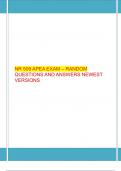
-
NR 509 APEA EXAM – RANDOM QUESTIONS AND ANSWERS NEWEST VERSIONS
- Exam (elaborations) • 35 pages • 2023
-
- $13.49
- + learn more
NR 509 APEA EXAM – RANDOM QUESTIONS AND ANSWERS NEWEST VERSIONS NR 509 APEA EXAM – RANDOM Question: A transient ischemic attack is: a transient episode of neurologic dysfunction by focal brain, spinal cord, or retinal ischemia, without acute infarction. Correctan infarction of the central nervous system tissue that may be silent or abrupt onset of motor or sensory deficits. Incorrectfocal or asymmetric weaknesses caused by central and peripheral nerve damage. Ex...
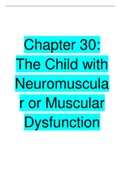
-
Chapter 30: The Child with Neuromuscula r or Muscular Dysfunction Hockenberry: Wong's Essentials of Pediatric Nursing, 10th Edition
- Exam (elaborations) • 26 pages • 2022
-
- $12.49
- + learn more
1. The nurse is planning a staff in-service on childhood spastic cerebral palsy. What characterizes spastic cerebral palsy? a. Hypertonicity and poor control of posture, balance, and coordinated motion b. Athetosis and dystonic movements c. Wide-based gait and poor performance of rapid, repetitive movements d. Tremors and lack of active movement - ANS: A Hypertonicity and poor control of posture, balance, and coordinated motion are part of the classification of spastic cerebral pals...

-
Neurology NCLEX Questions and Answers (A Grade) 2023
- Exam (elaborations) • 14 pages • 2023
-
Available in package deal
-
- $9.99
- + learn more
Neurology NCLEX Questions and Answers (A Grade) 2023 During hospitalization, a child experiences a tonic-clonic seizure. To provide for the client's safety, which of the following actions should the nurse take? 1. Put a padded tongue blade between the child's teeth 2. Perform a jaw thrust and administer oxygen 3. Securely restrain the child in the bed 4. Administer a benzodiazepine intramuscularly - 2. To provide for the safety of the child during a tonic-clonic seizure, the nurse shoul...

How much did you already spend on Stuvia? Imagine there are plenty more of you out there paying for study notes, but this time YOU are the seller. Ka-ching! Discover all about earning on Stuvia


